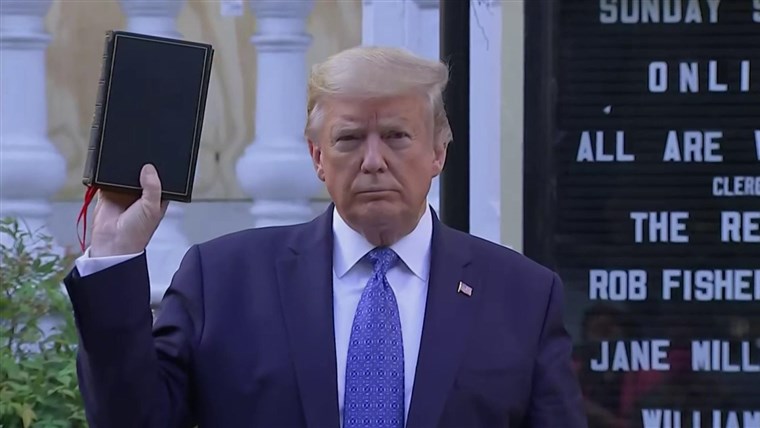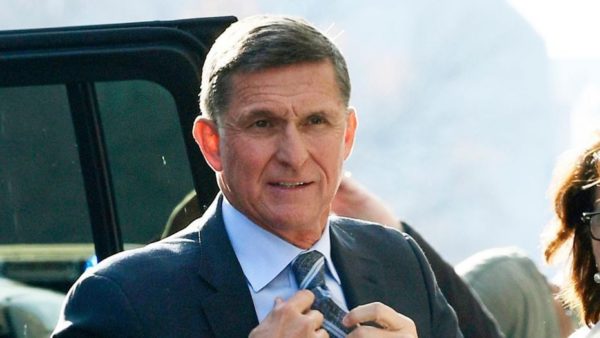WASHINGTON — As sirens wailed and flash-bang grenades popped across the street, President Donald Trump announced from the Rose Garden that he would use the U.S. military to stop the riots across the country that have been sparked by the death of George Floyd.
“I am mobilizing all available federal resources, civilian and military, to stop the rioting and looting, to end the destruction and arson and to protect the rights of law-abiding Americans, including your Second Amendment rights,” Trump said in the extraordinary address, which was delivered as police fired smoke devices outside to push protesters back from the White House.
“We are ending the riots and lawlessness that has spread throughout our country. We will end it now,” Trump said.
Trump said that governors should deploy the National Guard in great numbers so that they “dominate the streets.”
“If a city or state refuses to take the actions necessary to defend the life and property of their residents, then I will deploy the United States military and quickly solve the problem for them,” Trump said, referring to himself as “your president of law and order and an ally of all peaceful protesters.”
He said he was already dispatching “thousands and thousands of heavily armed soldiers, military personnel and law enforcement officers” to Washington to stop the violence that has been a feature of the protests here.
Shortly before he started to speak — about 20 minutes before Washington’s 7 p.m. ET curfew — U.S. Park Police and the National Guard had started using smoke and flash-bangs to push away the large crowd of peaceful protesters outside. D.C. Mayor Muriel Bowser complained on Twitter that the move would “make the job of @DCPoliceDept officers more difficult.”
Full coverage of George Floyd’s death and protests around the country
It soon became clear why the authorities had forcibly cleared Lafayette Square and its surrounding streets of peaceful protesters. Concluding his remarks, Trump said he was going to “pay my respects to a very, very special place.” Then, surrounded by many of his West Wing aides, he walked across the street that had been cleared in order to stand outside St. John’s Episcopal Church, which suffered fire damage in protests Sunday night.
Trump held up a Bible outside the church, posed for pictures and then returned to the White House. He did not go in the church or express any religious sentiments there.
The Rt. Rev. Mariann Budde, bishop of the Episcopal Diocese of Washington, who oversees the church, told The Washington Post that she found out about the visit when it was shown on television and that she was “outraged” by what she saw.
She said she “was not given even a courtesy call that they would be clearing with tear gas so they could use one of our churches as a prop, holding a Bible, one that declares that God is love, and when everything he has said and done is to inflame violence.”
Democrats blasted the move, as well.
“The desire for a certain backdrop for a press announcement is not a security requirement,” Sen. Brian Schatz, D-Hawaii, tweeted. “In other words, using the power of the U.S. Military to clear out peaceful protestors for a presser is a massive abuse of power. “
Sen. Kamala Harris, D-Calif., was more succinct. “Donald Trump just tear-gassed peaceful protesters for a photo op,” she tweeted.
New York Gov. Andrew Cuomo called the decision “shameful.”
Asked whether the area was cleared to accommodate Trump’s visit to the outside of the church, White House deputy press secretary Judd Deere said: “The perimeter was expanded to help enforce the 7 p.m. curfew in the same area where rioters attempted to burn down one of our nation’s most historic churches the night before. Protesters were given three warnings by the U.S. Park Police.”
To activate the military to operate in the U.S., Trump would have to invoke the 213-year-old Insurrection Act, which four people familiar with the decision had told NBC News he planned to do.
The military police forces would come from Fort Bragg, North Carolina, and possibly Fort Belvoir, Virginia, and they could arrive in Washington within hours, these people said.
The chair of the House Armed Services Committee, Rep. Adam Smith, D-Wash., urged Trump to reverse course.
“The domestic deployment of our armed services is an incredibly serious undertaking that should not be taken lightly,” Smith said. “We live in a democracy, not a dictatorship,” he added, urging Trump to use the powers of the presidency “to calm tensions across the country, not escalate them.”
Trump’s decision on whether to invoke the act, adopted in 1807, to deploy troops has come as his frustrations mount over the protests that have followed the death of Floyd, a black man who died in police custody last week in Minneapolis. The people familiar with his decision said Trump was angry Sunday night at the destruction some protesters caused in Washington, particularly the vandalizing of national monuments.
Some of the president’s aides have been encouraging him for days to invoke the act as he weighed options to exercise executive powers to address the crisis. The act was last invoked during in 1992 during riots over the police beating of Rodney King.
Trump’s remarks came hours after he urged the nation’s governors to get “tough” with unruly demonstrators. “Most of you are weak,” he told them, according to audio of the call obtained by NBC News. “You have to dominate. If you don’t dominate, you’re wasting your time. They’re going to run over you. You’re going to look like a bunch of jerks,” the president said.
At a briefing with reporters Monday, White House press secretary Kayleigh McEnany had left open the possibility that the president could invoke the Insurrection Act.
“The Insurrection Act, it’s one of the tools available. Whether the president decides to pursue that, that’s his prerogative,” McEnany said.
Governors can ask the federal government to send active-duty troops to help in cases of civil unrest like the widespread protests plaguing cities over the last several days. But so far, no governor has requested active-duty troops to assist. Instead, they have relied on local law enforcement and National Guard soldiers and airmen on state active duty.
Download the NBC News app for full coverage and alerts on this story
Governors often prefer the National Guard forces in these cases because they can legally perform law enforcement duties in the U.S., whereas troops on active duty cannot without violating the Posse Comitatus Act, a 1878 law that prohibits the government from using military forces to act as a police force within U.S. borders.
But the president could invoke the Insurrection Act to deploy active-duty forces without a request from a governor. Those troops would be allowed to conduct law enforcement missions. To invoke the act, Trump would first have to issue a proclamation to “immediately order the insurgents to disperse and retire peaceably to their abodes within a limited time,” according to the law.
In the past, the Justice Department has drafted such proclamations. And according to the Congressional Research Service, the act has been invoked many times throughout U.S. history, although rarely since the 1960s civil rights era.
When it was invoked in 1992 during the Los Angeles riots, the move was requested by California Gov. Pete Wilson, not invoked solely by President George H.W. Bush. Trump’s attorney general, William Barr, was Bush’s attorney general the last time the act was invoked, and he led the Justice Department’s response to the King beating.
The Defense Department declined to comment on the possibility that the president could invoke the act.
One of Trump’s allies outside the White House, Sen. Tom Cotton, R-Ark., urged Trump to invoke the Insurrection Act “if necessary” so U.S. troops can “support our local law enforcement and ensure that this violence ends tonight.”
CORRECTION (June 2, 2020, 6:35 p.m. ET): An earlier version of this article misstated the name of the committee of which Rep. Adam Smith, D-Wash., is chair. It is the House Armed Services Committee, not the House Service Committee.


